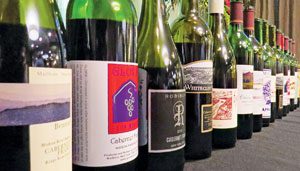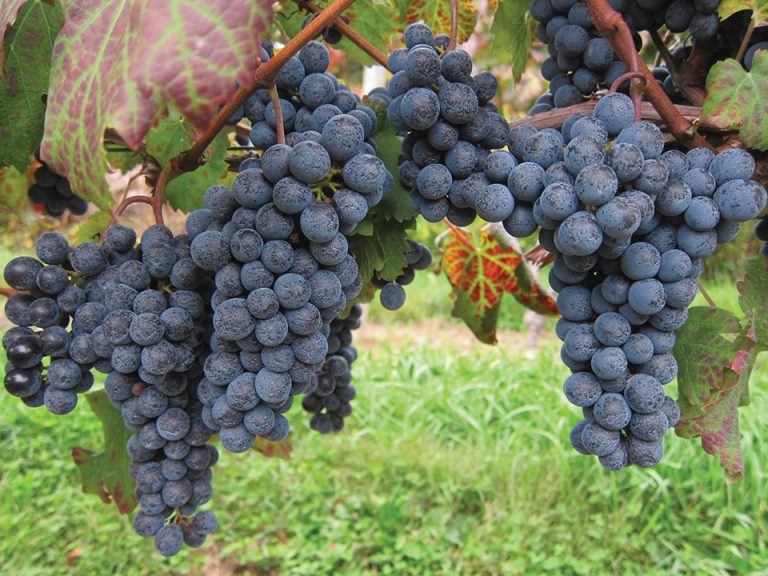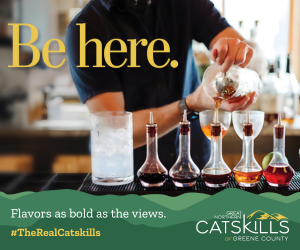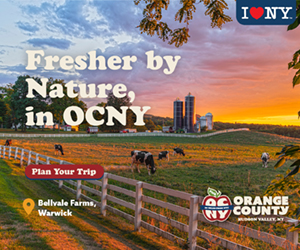The verdant, hilly climes of the Hudson Valley are known and praised for many things. The beauty of its rolling, roiling namesake river; its famed mid-nineteenth century naturalist art movement; its acres of multi-generational fruit orchards and dairy farms; and, lately, as the celebrated place of culinary inspiration for chefs like Dan Barber and Zak Palaccio. But while these lands, just ninety minutes shy of New York City’s northern border, can claim the country’s oldest, continually operating vineyards and oldest declared winery, the cult of wine has yet to become the calling card of the region’s lore and allure.
That might be about to change.
Cabernet Franc, that beautiful, black French grape variety well known for its role in both legendary Right Bank Bordeaux and Loire Valley wines, is proving to be oh-so much more than a liquidy lark here. Not only does the grape seem well at home in the Hudson Valley’s cool-climate terroir, but collective work done between the area’s grape growers, winemakers, and Cornell University have tamed many of the conundrums that once plagued producers who yearned for success with vinifera.
Now, with a force borne of a few decades of trial, error, and recent promising success, Hudson Valley vintners are ready (and more than able) to stick a flag in the ground for Franc.
Digging Down
“I’m of Dutch-German descent; I’m not big on failure,” laughs Doug Glorie, who with his wife and partner, MaryEllen, opened Glorie Farm Winery in Marlboro in 2004 on the lands they’d been farming since the late 1970s. As for many Hudson Valley winemakers, that notion long translated into growing mostly cold-hearty hybrid grape varieties. But while hybrid grapes like Seyval, Vidal, Baco Noir and De Chaunac have been popular in the tasting rooms, their reach hasn’t grabbed the kind of notoriety and respect that vinifera does (think Riesling in the Finger Lakes and Merlot on Long Island).
In spring 2016, the Glories, along with Linda Pierro and Robert Bedford of Hudson Valley Wine Magazine, co-founded the Hudson Valley Cabernet Franc Coalition, a group of about two dozen area winemakers and grape growers who’ve committed not just to putting Cabernet Franc front and center for the region, but to having a consistent meeting of the minds on how and where to best grow it. Not only that, but established and new producers alike are keen to plant more: From Millbrook, Whitecliff, Benmarl, and Robibero to Nostrano, Brunswick Winery, and Milea Estate Vineyards, among the many.
“We like to be confident,” Glorie says. “We would not be rolling this out if the wines we’re making here couldn’t stand up to other regions of the world.”
Indeed, sip on the Glorie’s 2014 Cab Franc from a southeast-facing acre they have planted on their farm, and its bright, juicy raspberry and cherry-scented fruit isn’t just something that makes you think, “This is good for the Hudson Valley.” It just makes you think, “This is good!” And that’s exactly the point.
“You can see that rich, plush velvetiness that the Hudson River Valley gets. They’re softer and the oak use has gotten to be much more balanced. As winemakers are becoming more confident in the grapes they’re getting from growers or the grapes they’re growing themselves, the fruit is really showing through,” says Anna Lee Iijima, Wine Enthusiast contributing editor specializing in New York wines.
Iijima, who headed up a sold-out seminar on New York Cabernet Franc at the annual NY Drinks NY tasting in Manhattan this past March, has been keeping an eye on the Hudson Valley’s progress. “Some of the stuff coming out of the Hudson Valley, like Millbrook, Benmarl, Whitecliff, and Glorie—it’s been consistently high-quality. And over the last four to five years, we’re really seeing appellation-driven Hudson River Valley region Cab Franc instead of just ‘New York’ Cab Franc,” she offers. “We’re seeing a lot more of a regionally focused, appellation proud representation. And it’s really kind of mind blowing.”
Over the last four to five years, we’re really seeing appellation-driven Hudson River Valley region Cab Franc instead of just ‘New York’ Cab Franc.
—ANNA LEE IIJIMA, Wine Enthusiast
Indeed, there is no amount of smoke, mirrors, and expensive oak treatment that can make a grape that’s not growing well in a region express itself with the kind of purity that wins critical acknowledgment. Science and logic must be behind it. Cabernet Franc from Bordeaux or the Loire Valley in France aren’t grown there because it sounds good in a press release; it’s the collective land, climate, and know-how that gave birth to some of the greatest wines known to humankind.
“I have a heavier soil similar to the Pomerol region of France. I don’t have perfect conditions, but I know renowned wine regions make the best wines from similar conditions,” reasons Ryan Selby, assistant winemaker and vineyard manager for Robibero Vineyards in New Paltz. “If the Hudson Valley wants to identify itself with vinifera, it’s Cab Franc.”
Kristop Brown, head winemaker for Robibero, agrees. “It’s not like, oh, it tastes like Loire Valley Cab Franc! It doesn’t. And when you drink Cab Franc from California and other new world regions, it loses something. It’s big and bold, but that’s not what Cab Franc wants to be,” he says. “And you know, it’s really exciting to be on the ground floor of something.”
While members like Michael Migliore, long-time owner with his wife Yancey of Whitecliff Vineyards in Gardiner, might use the word “marketing” in conversation about the Cab Franc Coalition, he and the rest of the group know full well that the notion of a region hanging its collective hat on a grape or two isn’t just about appearances and outreach; it’s about doing the work. Here, that has translated into years and years of experimenting with different clones, rootstock, site selection, barrel treatment, and blending.
Announcing the Hudson Valley Cabernet Franc Coalition
The Hudson Valley Cabernet Franc Coalition (HVCFC) is a group of Hudson Valley winery owners, grape growers, winemakers, and wine industry supporters committed to establishing a Cabernet Franc brand identity for the Hudson River Region. Founded in early 2016 under the umbrella of the Hudson Valley Wine and Grape Association, the Coalition has been quickly gaining wide-spread support from both new and well-established producers.
Simply put, the Coalition’s mission is to encourage more vineyard plantings of the Cabernet Franc grape and boost recognition of the Hudson Valley’s distinctive Cabernet Franc wines.
Starting this summer, special promotions and events will be announced to promote the region’s terroir-driven Cab Francs. Support the Coalition! Take part in these activities and support the efforts of its members to claim Cabernet Franc as the signature grape of the Hudson Valley. Look for updates on their website.
One of the main reasons Cabernet Franc ever found a consistent home here is that it’s one of the few popular vinifera varieties that can handle the cold weather inherent in Hudson Valley winters. “Cab Franc is heartier—it can handle temperatures to around -9, -10,” says Migliore, president of the Hudson Valley Wine and Grape Association (HVWGA). It was something he learned early on when he planted his first vinifera vines—19 acres of Chardonnay, Gamay Noir, and Cab Franc. “The first 10 years, it was like throwing spaghetti on the wall, but if you look at a benchmark like Cheval Blanc,” he says of the famed Cab Franc-centric Right Bank Bordeaux, “and ask if that climate is so different from ours, the answer is it’s not.” What was different, it turns out, is the way Hudson Valley growers were handling Cabernet Franc in the vineyard.
The Key to the Cab
“For me, it’s the main vinifera red that works well consistently,” says Lenn Thompson of New York Cork Report, a website that’s devoted its content to both celebrating and critiquing the wines from New York State’s AVAs. The challenge, Thompson believes, comes in the form of getting even more entirely HRV-grown Cab Franc in the bottle. Indeed, in the past and present, too, it’s been necessary to supplement at times with Cab Franc from the Finger Lakes, Long Island, or both. But if recent and soon-to-be plantings, the new Coalition’s devotion to the grape, as well as findings on how to best grow Cab Franc in the region prove anything, it’s that Hudson Valley AVA-centric versions are on the rapid rise.
While Cab Franc has shown the kind of cold-tolerant vinifera promise in the Hudson Valley that has made producers like Glorie, Whitecliff, and Millbrook (who currently has about seven acres, with three to four more planned for the near future) committed to growing it for decades, issues like killer cold temperatures, struggles with overcropping, and green flavors made the final results a moving target from vintage to vintage. That is, until Cornell University’s Cooperative Extension found the fix that appears to have unlocked the Hudson Valley’s ultimate potential with the grape.
Instead of the pretty, ripe raspberry and red-berry fruit flavors, certain vintages yielded Cab Francs that, despite longer time left ripening on the vine past their normal harvest point in early October, were not only lousy with green, vegetal notes that left growers scratching their heads, they were put in peril’s way by risking exposure to potential frosts as the fall season wanes on.
Enologist Gavin Sachs and a team of Cornell researchers discovered that getting rid of those undesirable green bell pepper notes that have plagued the wines actually didn’t have anything to do with the grapes being “riper”; but it did have everything to do with managing the growth of a particular chemical compound in the grape far earlier on in the season.
It was found that methoxypyrines—a difficult mouthful in both name and manifestation—or MPs, can be wrestled under control with more sun exposure on the grapes earlier in their development. Manage your vine’s canopy by getting rid of some leaves early in the season and you get rid of those not-sodesired flavors, too. Voilà. “Applying that discovery in the mid-aughts changed the game for me,” Migliore, a passionate and careful grower, marvels.
More good news: Using certain rootstock (specifically, that of the native riparia) also helped to boost the potential for staving off the unfortunate effects of cold-snaps by producing vines that ripen a good week to 10 days earlier in the growing season.
Add to that the nuances of clonal selection to zero in on the versions that glean the best color, concentration, and traditional desirable notes from the Valley’s glacial silt, slate, and clay soils, and producers can spend more time managing their vineyards than worrying about unnecessary damage control. All of which adds up to an easier decision for Coalition members who want to commit more acres to Cab Franc rather than hybrids. In fact, Cornell’s Hudson Valley Research Laboratory in Highland, NY, plans to rip out an acre of experimental grapes and plant it entirely to different clones of Cab Franc to further study how different versions best thrive and express themselves.
“The clones available in the last 15 years from [the French research authorities] ENTAV/INRA are a big improvement over those available in the ’80s early ’90s,” says John Graziano, the longtime winemaker for Millbrook. “We have had good success with clone 214 and excellent results with clones 327 and 623.”
Migliore has about eight acres of Cab Franc in the ground now, much of it clone 1, although he’s moving toward the French clones 327 and 214. He’s also designating a portion of the five-acre parcel he recently leased just below Olana, in Columbia County, NY, to the grape, too. At Robibero, Selby has an acre of clone 1, which you can see on the left as soon as you pull into driveway leading to the winery and tasting room. On the right is a new vineyard planted last year of clones 1 and 327. Soon, he’ll be adding some clone 312 to the mix, too.
“Those clones are good for controlling vigor and they have medium-sized clusters—you don’t want anything too tight because of the crazy humidity,” Selby says. “I also wanted to experiment with a few different clone types to see what I like and what I want to plant more of. Different clones can add to the complexity of the blend.”
At Benmarl—the oldest continuously operated vineyards in the country, which were purchased by the Spaccarelli family in 2006—one of the area’s younger winemaker and vineyard managers, Matt Spaccarelli, has three Cab Franc acres planted on his family’s 38 acre farm; two and a half more of clones 214 and 12 went in the ground this spring. His 100 percent estate-grown Cab Francs don’t just express a clarity and varietal exactness that makes the grape’s nature come through like a clanging church bell, they offer something else; something uniquely, excitingly pure Hudson Valley.
Tasting the 2010, 2012 and 2014 side by side certainly shows the curious tweak of vintage variation and tells that wonderful, nail-biter story of a year in a glass. But they also show that, when grown and cared for thoughtfully and carefully, the particularity of the wines from this region translate into an alert sort of freshness inherent year after year; a clarity and depth of fruit that expresses itself in violets and raspberries; cherries and a gentle peppery quality. And deep beneath the surface, like the land from which is comes, a quiet hum of minerality. This is Hudson Valley Cab Franc. And this is why everyone from pioneers like Graziano, Migliore, and Glorie to the fresh faces like Spaccarelli and Selby are willing to—literally—put stakes in the ground and claim the grape to all the wine consuming world as one of their own.
“If it were all up to me, I’d plant our whole 38 acres in Cabernet Franc,” smiles Spaccarelli, standing with a glass of the 2014 Fjord Cab Franc, his own just-launched label, in his hand, the verdant sweep of the valley breathtaking out the tasting room window just beyond his left shoulder. Perhaps, not in the so very distant future, he will have his wish.
Blind Tasting Notes






